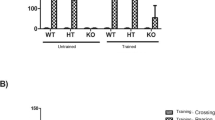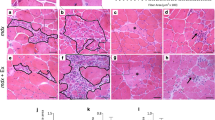Abstract
Duchenne muscular dystrophy (DMD) is a condition caused by an amendment to the X chromosome, inherited as a recessive trait, and affects 1:3500 live births, especially males. Low-intensity exercise is known to decrease certain parameters associated with muscular degeneration in animal models of progressive muscular dystrophies. In the present study, 28-day-old male mdx and wild-type (wild) mice were used. The animals were subjected to a low-intensity physical exercise protocol for 8 weeks. It was found that this protocol was able to reduce oxidative stress in muscle tissue and in most of the CNS structures analyzed, with a significant increase in antioxidant activity in all analyzed structures. It is thus possible to infer that this exercise protocol was able to reduce oxidative stress and improve the energy metabolism in brain tissue and in the gastrocnemius muscle of animals with DMD.








Similar content being viewed by others
Availability of Data and Material
Not applicable.
References
Abou-Samra M, Lecompte S, Schakman O, Noel L, Many MC, Gailly P et al (2015) Involvement of adiponectin in the pathogenesis of dystrophinopathy. Skelet Muscle 7(5):25
Alemdaroğlu Đ, Karaduman A, Yilmaz ÖT, Topaloğlu H (2015) Different types of upper extremity exercise training in Duchenne muscular dystrophy: effects on functional performance, strength, endurance, and ambulation. Muscle Nerve 51(5):697–705
Andersen SP, Sveen ML, Hansen RS, Madsen KL, Hansen JB, Madsen M, Vissing J (2013) Creatine kinase response to high-intensity aerobic exercise in adult-onset muscular dystrophy. Muscle Nerve 48:897–901
Berchicci M, Lucci G, DiRusso F (2013) Benefits of physical exercise on the aging brain: the role of the prefrontal cortex. J Gerontol A Biol Sci Med Sci 68:1337–1341
Coelho FG, Gobbi S, Andreatto CA, Corazza DI, Pedroso RV, Santos-Galduroz RF (2013) Physical exercise modulates peripheral levels of brain derived neurotrophic factor (BDNF): a systematic review of experimental studies in the elderly. Arch Gerontol Geriatr 56:10–15
Comim CM, Lucca G, Valvassoria SS, Réusa GZ, Vuolob F, Pedronilhob F et al (2009) Effects of chronic mild stress model on the oxidative damage parameters in the rat brain. Neurochem Int 54(5–6):358–362
Dalton J, Goldman JS, Sampson JB (2015) The muscular dystrophies. In: Goldman JS Genetic Counseling for Adult Neurogenetic Disease. Springer, Boston, MA, pp 251–262
Draper HH, Hadley M (1990) Malondialdehyde determination as index of lipid peroxidation. Methods Enzymol 186:421–431
Eagle M (2002) Report on the muscular dystrophy campaign workshop: exercise in neuromuscular diseases. Neuro Dis 12:975–983
Fischer JC, Ruitenbeek W, Berden JA, Trijbels JM, Veerkamp JH, Stadhouders AM et al (1985) Differential investigation of the capacity of succinate oxidation in human skeletal muscle. Clin Chim Acta 153:23–26
Gevaerd MS, Domenech SC, Junior NGB, Higa DF, Lima-Silva AE (2010) Alterações fisiológicas e metabólicas em indivíduo com distrofia muscular de Duchenne durante tratamento fisioterapêutico: um estudo de caso. Fisiot Mov 23(1):93–103
Jansen M, Alfen NV, Geurts ACH, Groot IJM (2013) Assisted bicycle training delays functional deterioration in boys with Duchenne muscular dystrophy: the randomized controlled trial “no use is disuse”. Neurorehabilit Neural Repair 27(9):816–827
Halliwell B (2006) Oxidative stress and neurodegeneration: where are we now? J Neuro 97:1634–1658
Houang EM, Sham YY, Bates FS, Metzger JM (2018) Muscle membrane integrity in Duchenne muscular dystrophy: recent advances in copolymer-based muscle membrane stabilizers. Skelet Muscle 8(31):1–19
Hughes BP (1962) A method for estimation of serum creatine kinase and its use in comparing creatine kinase and aldolase activity in normal and pathologic sera. Clin Chim Acta 7:597–603
Hyzewicz J, Ruegg UT, Takeda S (2015a) Comparison of experimental protocols of physical exercise for mdx mice and Duchenne muscular dystrophy patients. J Neuromuscul Dis 2:325–242
Hyzewicz J, Tanihata J, Kuraoka M, Ito N, Miyagoe-Suzuki Y, Takeda S (2015b) Low intensity training of mdx mice reduces carbonylation and increases expression levels of proteins involved in energy metabolism and muscle contraction. Free Radic Biol Med 82:122–136
Ishii H, Nishida Y (2013) Effect of lactate accumulation during exercise-induced muscle fatigue on the sensorimotor cortex. J Phys Ther Sci 25:1637–1642
Kaczor JJ, Hall JE, Payne E, Tarnopolsky MA (2007) Low intensity training decreases markers of oxidative stress in skeletal muscle of mdx mice. Free Radic Biol Med 43:145–154
Kogelman B, Putker K, Hulsker M, Tanganyika-de Winter C, van der Weerd L, Aartsma-Rus A et al (2018) Voluntary exercise improves muscle function and does not exacerbate muscle and heart pathology in aged Duchenne muscular dystrophy mice. J Mol Cell Cardiol 125:29–38. https://doi.org/10.1016/j.yjmcc.2018.10.008
Kostek M (2019) Precision medicine and exercise therapy in Duchenne muscular dystrophy. Sports 7(3):64. https://doi.org/10.3390/sports7030064
Le Rumeur E (2015) Dystrophin and the two related genetic diseases, Duchenne and Becker muscular dystrophies. Bosn J Basic Med Sci 15(3):14–20
Levine A, Tenhaken R, Dixon R, Lamb C (1994) H2O2 from the oxidative burst orchestrates the plant hypersensitive disease resistance response. Cell 79:583–593
Ljubicic V, Burt M, Jasmin BJ (2014) The therapeutic potential of skeletal muscle plasticity in Duchenne muscular dystrophy: phenotypic modifiers as pharmacologic targets. FASEB J 28:548–568
Lidov HG, Byers TJ, Watkins SC, Kunkel LM (1990) Localization of dystrophin to postsynaptic regions of central nervous system cortical neurons. Nature 348(6303):725–728
Machado FB, Gobatto CA, Contarteze RVL, Papoti MP, Mello MAR (2006) Máxima fase estável de lactato é ergômetro-dependente em modelo experimental utilizando ratos. Rev Bras Med Esp 5(12):259–262
Mankodi A, Azzabou N, Bulea T, Reyngoudt H, Shimellis H, Ren Y et al (2017) Concentric exercise effects on skeletal muscle water T2 in Duchenne muscular dystrophy (P2. 131). Neurology 88(16 Supplement):P2–131
Markert CD, Case LE, Carter GT, Furlong PA, Grange RW (2012) Exercise and Duchenne muscular dystrophy: where we have been and where we need to go. Muscle Nerve 746–751
Matthew PW (2013) The muscular dystrophies. Continuum J 19(6):1535–1570
Moreira-Marconi E, Sá-Caputo DC, Dionello CF, Guedes-Aguiar EO, Sousa-Gonçalves CR, Morel DS et al (2017) Whole-body vibration exercise is well tolerated in patients with Duchenne muscular dystrophy: a systematic review. Afr J Tradit Complement Altern Med 14(4 Suppl):2–10. https://doi.org/10.21010/ajtcam.v14i4S.1
Partridge TA (2013) The mdx mouse model as a surrogate for Duchenne muscular dystrophy. FEBS J 280:4177–4186
Rustin P, Chretien D, Bourgeron T, Gérard B, Rötig A, Saudubray JM et al (1994) Biochemical and molecular investigations in respiratory chain deficiencies. Clin Chim Acta 288:35–51
Savino W, Pinto-Mariz F, Mouly V (2018) Flow cytometry-defined CD49d expression in circulating T-lymphocytes is a biomarker for disease progression in Duchenne muscular dystrophy. In: Bernardini C (ed) Duchenne Muscular Dystrophy. Humana Press, New York, pp 219–227
Shan X, Aw TY, Jones DP (1990) Glutathione-dependent protection against oxidative injury. Pharmacol Ther 47:61–71
Timpani CA, Hayes A, Rybalka E (2015) Revisiting the dystrophin-ATP connection: how half a century of research still implicates mitochondrial dysfunction in Duchenne muscular dystrophy aetiology. Med Hypotheses
Tuon L, Comim CM, Fraga DB, Scain G (2010) Mitochondrial respiratory chain and creatine kinase activities in the brain mdx mouse. Muscle Nerve 257–264
Urhausen A, Coen B, Weiler B, Kindermann W (1993) Individual anaerobic threshold and maximum lactate steady state. Int J Sports Med 14:134–139
Acknowledgements
This research was supported by grants from UNESC (PCLS) and UNISUL (CMC).
Code Availability
Not applicable.
Author information
Authors and Affiliations
Contributions
All authors contributed to the study conception and design. Material preparation, data collection and analysis were performed by Andreza Hoepers, Adriano Alberti, Viviane Freiberger, Letícia Ventura, Leoberto Ricardo Grigollo, Cristina Salar Andreau, Bruna Becker da Silva, Daniel Fernandes Martins, Rudy José Nodari Junior, Emilio L. Streck, Clarissa M. Comim.
The first draft of the manuscript was written by Andreza Hoepers and all authors commented on previous versions of the manuscript. All authors read and approved the final manuscript.
Corresponding author
Ethics declarations
Conflict of Interest
The authors declare that there is no conflict of interest with regard to the content of this manuscript or funding sources.
Ethical Statement
All procedures were performed in compliance with the Brazilian Society of Neuroscience. This project was approved of by the Animal Use Ethics Committee (CEUA) of Unisul under number 14.017.4.08.IV.
Additional information
Publisher’s Note
Springer Nature remains neutral with regard to jurisdictional claims in published maps and institutional affiliations.
Rights and permissions
About this article
Cite this article
Hoepers, A., Alberti, A., Freiberger, V. et al. Effect of Aerobic Physical Exercise in an Animal Model of Duchenne Muscular Dystrophy. J Mol Neurosci 70, 1552–1564 (2020). https://doi.org/10.1007/s12031-020-01565-0
Received:
Accepted:
Published:
Issue Date:
DOI: https://doi.org/10.1007/s12031-020-01565-0




